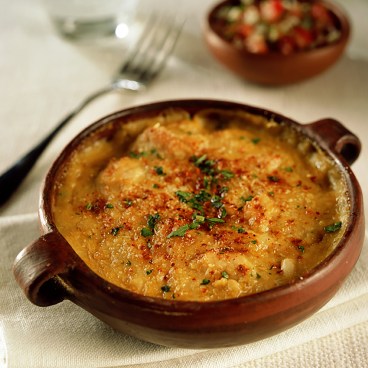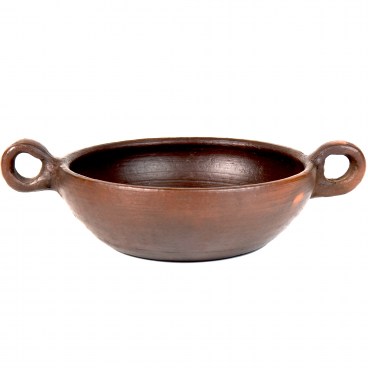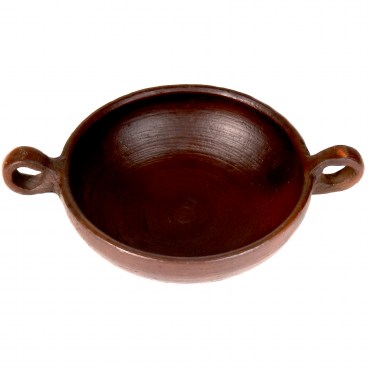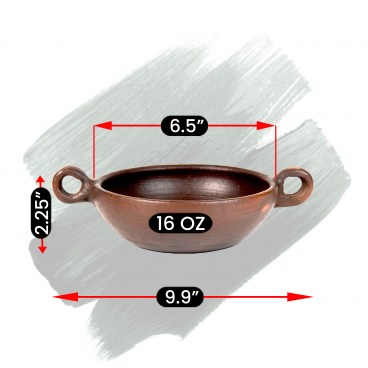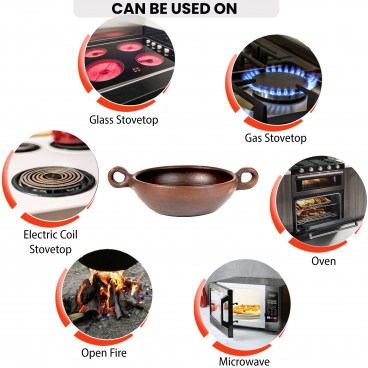
Pomaireware Round Serving Dish
About the piece
Care and Use
Curing
How they are Made
Recipes
This beautiful two handled dish is perfect for serving any au gratin dishes, and especially made for serving Pastel de Choclo. The dish is unglazed earthenware, thick and good at even heat distribution. They can be used in the oven or broiler, on a stove top, over a an open flame or even on charcoal, for roasting, sautéing, boiling or simmering, and for serving. It keeps food warm for a long time. The outside finish is the result of a smoking process which results in an uneven dark brown exterior.
| Item Number: | CHL-3029-06 |
| Dimensions (inches): | |
| Length: | 9.0 |
| Width: | 6.5 |
| Height: | 2.25 |
| Capacity: | 16 oz |
| How we measure |  |
About Pomaireware™
One of the most important characteristics of Chilean Creole cuisine the clay vessels from Pomaire. They come in a variety of sizes and shapes, from the classic olla (pot), to casseroles, pitchers, water jars, plates and bowls; they hold heat wonderfully and impart a special flavor to food, and can be used in the oven or directly over a flame. A pastel de choclo (corn pie) or paila marina (seafood stew) is almost unimaginable in anything else.
Pomaire is a village of 10,000 or so, some 35 miles SE of Santiago, Chile and an attractive tourist destination for visitors who come to buy the world renowned pottery and enjoy the Chilean Creole cuisine. The city’s pottery or Pomaireware™ has put it on the map in the culinary world.
Appearance
As with most handmade products by artisans around the world, the pieces may have slight imperfections in the form or finish of the materials. Sometimes sizes of same model pieces may also vary slightly, however, these imperfection do not compromise the aesthetics or functionality of the pieces and are considered normal and to be expected. This is especially evident on the outside coloration which depending on its position inside the kiln, the coloration pattern and intensity will be unique to the piece. Likewise, although lids are made individually to match each pot, they do not always fit perfectly as the two parts may shrink differently during the firing process.
You may observe with certain use that your pieces may change in color, especially on the bottom where there is direct contact with heat. This is normal and does not affect the pieces in any way.
Pomaireware™ is well made and will last many years with proper use and care. The pieces can be used in the oven, in the microwave or a stovetop, and can go directly to the table for a sophisticated presentation. The pieces can be used directly on a gas or electric range, however, it is recommended to use a heat diffuser on electric ranges. The heat diffuser (which can be used with gas stove as well) has the added benefit of distributing the heat slowly to prevent foods from burning. Clay cookware can also be used on induction cooktops with the use of an induction cookware interface disk.
The pieces must not be submitted to drastic changes in temperature. The pieces should be allowed to adjust slowly to heat, letting them slowly heat up until they are hot, either on the stove or in the oven. Likewise, you should also allow the pieces to adjust to room temperature before washing or storing them, and never sit a hot pot on a cold surface such as granite or tile.
The pieces retain heat for a long period of time, therefore be careful in handling a hot pot.
For cleaning, avoid using the dishwasher and hand washing is recommended. After each use, fill with warm, soapy water, allowing to soak briefly if heavily soiled, then scrubbing lightly with a sponge or soft cloth.
Do not use metal or abrasive pads as they may scratch the surface and avoid strongly scented soaps which can flavor the clay. Use wooden utensils with the pieces as metal utensils can scratch and damage the inside.
Appearance
Appearance
As with most handmade products by artisans around the world, the pieces may have slight imperfections in the form or finish of the materials. Sometimes sizes of same model pieces may also vary slightly, however, these imperfection do not compromise the aesthetics or functionality of the pieces and are considered normal and to be expected. This is especially evident on the outside coloration which depending on its position inside the kiln, the coloration pattern and intensity will be unique to the piece. Likewise, although lids are made individually to match each pot, they do not always fit perfectly as the two parts may shrink differently during the firing process.
You may observe with certain use that your pieces may change in color, especially on the bottom where there is direct contact with heat. This is normal and does not affect the pieces in any way.
Before using your new Pomaireware™ piece, you should “cure” it. As soon as you wet the pieces, you will smell the raw clay (like smelling Chile itself!). The first thing you will need to do is to boil water in the pieces, or boil the small pieces in a larger pot.
The idea behind curing is to seal the pores of the clay. There are many techniques to accomplish this and each culture has its own tradition. In Chile, pots to be used for soups, stews, cooking beans, etc., are normally cured by rubbing butter all over the interior and putting the piece in a 350 degree oven for approximately 5 minutes, repeating the process at least one more time.
Some artisans use modern technology such as a potter’s wheel, but it remains an artisanal craft. The process begins by flattening a ball of clay and forming it around a mold specifically made for each model. This “shell” is then smoothed and trimmed and left to air dry, receiving a light polishing during the drying to make sure they have a smooth surface and free of sand.
The pieces are then fired in wood burning kilns. The firing process takes approximately three hours, with the furnace reaching approximately 750°C. The high heat and smoke from the wood result in beautiful brown pieces that are strong and utilitarian.
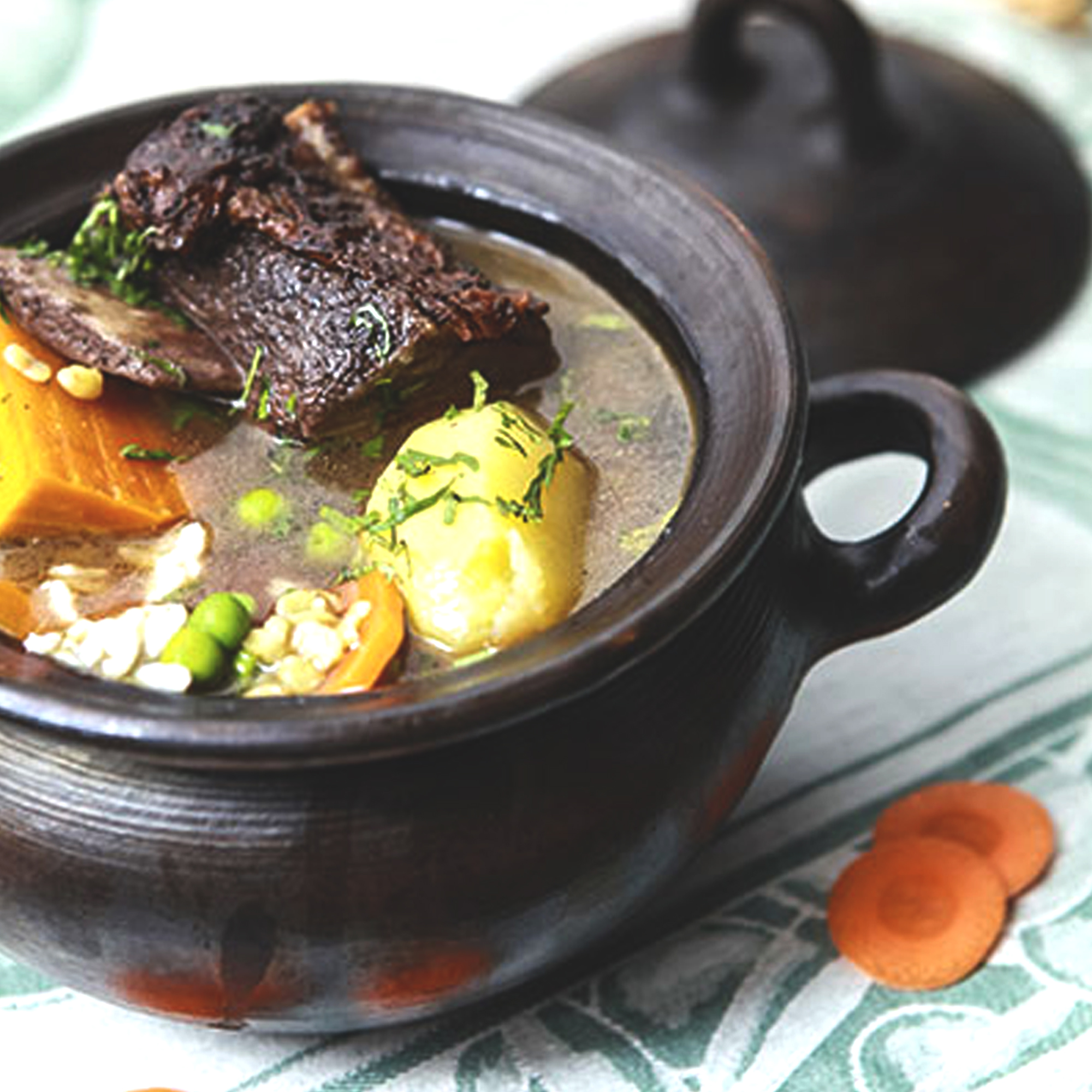
Cazuela Chilena, Chilean Stew
The Cazuela Chilena is one of the most traditional dishes in the Chilean gastronomy. It is very traditional and very adaptable. You make it with lamb, chicken, pork, or the more traditional beef. Certain ingredients though are not optional: potatoes, pumpkin, and corn on the cob.




